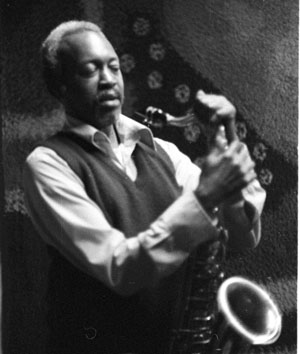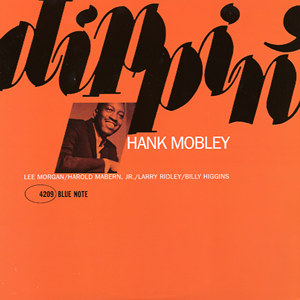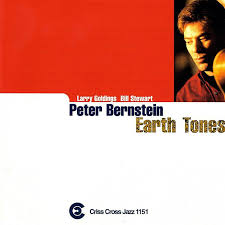Break Through – Hank Mobley
A funky, swinging riff blues with a twist—check out our notes to learn more about this head and how to play it.
- Recording: Hank Mobley - Dippin'
- Recorded on: June 18, 1965
- Label: Blue Note (BLP 4209)
- Concert Key: B-flat
- Vocal Range: , to
- Style: Swing (medium up)
- Trumpet - Lee Morgan
- Tenor Sax - Hank Mobley
- Piano - Harold Mabern
- Bass - Larry Ridley
- Drums - Billy Higgins
0:00
0:00
Buy MP3
- Description
- Historical Notes
- Solos
- Piano Corner
- Bass Corner
- Drum Corner
- Guitar Corner
- Inside & Beyond
- Minus You
Our audio excerpt begins at the top of the melody after the 8-measure drum intro. A riff blues with a twist, The Break Through offers some musical elements that you can apply in playing the blues. Starting on the "V" chord in the 9th measure, a cycle of dominant seventh chords descend in whole steps before resolving back to the melody. These alternative blues chord changes are applied to both the melody and the solo sections. The melody line is built on intervals of fourths, which can be a useful improvisational tool. This track is a funky swinger and leaves plenty of space for interplay between the rhythm section and the front line.
"Dippin'" was recorded at the legendary Van Gelder Studio in Englewood Cliffs.
Hank first recorded The Break Through on his "Dippin'" album for Blue Note, and this great Mobley blues line has been recorded by other important artists over the years. If you search to see if Hank recorded it himself again after his "Dippin'" date, you may not immediately find it, because when he did record it again on a session he co-led with Cedar Walton for the Muse label in 1972, it became the album title track and was labeled simply Breakthrough. So if you're searching for more recordings of this great Mobley head, be sure to search both titles. The correct title is The Break Through.
Hank first recorded The Break Through on his "Dippin'" album for Blue Note, and this great Mobley blues line has been recorded by other important artists over the years. If you search to see if Hank recorded it himself again after his "Dippin'" date, you may not immediately find it, because when he did record it again on a session he co-led with Cedar Walton for the Muse label in 1972, it became the album title track and was labeled simply Breakthrough. So if you're searching for more recordings of this great Mobley head, be sure to search both titles. The correct title is The Break Through.
A five-page in-depth drum transcription of Billy Higgins playing Hank Mobley's blues The Break Through.
-- eight-bar drum intro
-- time playing behind the melody in (two twelve-bar blues choruses)
-- 1st eight bars of time playing behind Hank Mobley's solo
-- four choruses of trading fours with drums (with stickings included)
-- time playing behind the melody out (two twelve-bar blues choruses)
This drum transcription features some of the best Billy Higgins has to offer. His cymbal beat is so strong throughout the recording. You can really hear clearly where his time feel falls, both straight and swung. Billy, of course, is known for his unique time feel and groove, but he takes some fantastic fours on this recording clip. Also make sure to check out Mobley and Higgins revisiting this song seven years later on the Cedar Walton/Hank Mobley recording "Breakthrough!"
-- eight-bar drum intro
-- time playing behind the melody in (two twelve-bar blues choruses)
-- 1st eight bars of time playing behind Hank Mobley's solo
-- four choruses of trading fours with drums (with stickings included)
-- time playing behind the melody out (two twelve-bar blues choruses)
This drum transcription features some of the best Billy Higgins has to offer. His cymbal beat is so strong throughout the recording. You can really hear clearly where his time feel falls, both straight and swung. Billy, of course, is known for his unique time feel and groove, but he takes some fantastic fours on this recording clip. Also make sure to check out Mobley and Higgins revisiting this song seven years later on the Cedar Walton/Hank Mobley recording "Breakthrough!"
Related Songs
Email Send Break Through to a friend
Send this page to a friend via email. Add your name or email in the first field. In the second, add one or more email addresses, separated by a comma.
- Recording: Peter Bernstein - Earth Tones
- Recorded on: December 14, 1997
- Label: Criss Cross Jazz (1151)
- Concert Key: B-flat
- Vocal Range: , to
- Style: Swing (medium up)
- Organ - Larry Goldings
- Guitar - Peter Bernstein
- Drums - Bill Stewart
- Description
- Historical Notes
- Solos
- Piano Corner
- Bass Corner
- Drum Corner
- Guitar Corner
- Inside & Beyond
- Minus You
Peter wasn't the first one to come up with the idea of starting this great Mobley blues head as a three-measure canon phrase, with the 2nd instrument starting one measure later, but Peter's recording did provide us with the idea of adding it to our DUETS category of our Guitar Corner.
It is certainly an interesting timbre with the organ echoing Peter's phrase.
Peter is the first soloist, and he and Larry Goldings (organ) add to the excitement generated by treating he melody in this way by starting the first solo chorus as a question/answer, with Peter starting. They continue in this manner for the first two solo choruses.
In the 3rd chorus, Larry switches to a comping role. At the 11 solo chorus, Peter and Larry do a simiiar approach to the very first solo chorus, with the two of them answering ideas for two choruses, then Peter switches to straight comping.
Our audio clip starts with a fade in to the melody; on the recording the drums provide a solo intro.
It is certainly an interesting timbre with the organ echoing Peter's phrase.
Peter is the first soloist, and he and Larry Goldings (organ) add to the excitement generated by treating he melody in this way by starting the first solo chorus as a question/answer, with Peter starting. They continue in this manner for the first two solo choruses.
In the 3rd chorus, Larry switches to a comping role. At the 11 solo chorus, Peter and Larry do a simiiar approach to the very first solo chorus, with the two of them answering ideas for two choruses, then Peter switches to straight comping.
Our audio clip starts with a fade in to the melody; on the recording the drums provide a solo intro.
Sometimes jazzleadsheets.com gets really lucky in the summer, as happened this year. We had two inters who were both guitar players, taking their summer break from Columbia University.
Peter Bernstein wasn't the first one to come up with the idea of starting this great Mobley blues head as a three-measure canon phrase, with the second instrument starting one measure later, but Peter's recording did provide us with the idea of adding it to our DUETS category of our Guitar Corner.
It is certainly an interesting timbre with the organ echoing Peter's phrase.
Peter is the first soloist, and he and Larry Goldings (organ) add to the excitement generated by treating he melody in this way by starting the first solo chorus as a question/answer, with Peter starting. They continue in this manner for the first two solo choruses.
As a Guitar Duo The first thing you realize, playing this with just two guitars, is that you really have to be on your toes without the cushion of having bass and drums under you. This, however, is great practice, really helping you keep your time together during the head. With two guitars you can easily add soloing before ending with the melody.
It is certainly an interesting timbre with the organ echoing Peter's phrase.
Peter is the first soloist, and he and Larry Goldings (organ) add to the excitement generated by treating he melody in this way by starting the first solo chorus as a question/answer, with Peter starting. They continue in this manner for the first two solo choruses.
As a Guitar Duo The first thing you realize, playing this with just two guitars, is that you really have to be on your toes without the cushion of having bass and drums under you. This, however, is great practice, really helping you keep your time together during the head. With two guitars you can easily add soloing before ending with the melody.
Related Songs
Email Send Break Through to a friend
Send this page to a friend via email. Add your name or email in the first field. In the second, add one or more email addresses, separated by a comma.

Hank Mobley
July 7, 1930 – May 30, 1986
Hank Mobley is one of the most acclaimed tenor saxophonists in modern jazz history. He is recognized by musicians and critics alike as one of the most important and eloquent jazz instrumentalists of all time. He recorded well over 100 of his own original compositions and left an indelible mark on the post-bop jazz scene. Read more...
There was a problem.
...





